Reserve Bank of Australia Annual Report – 2001 Financial System Stability
Concern with the overall stability of the financial system is a traditional and core responsibility of central banks. The environment most conducive to financial stability is one of low and stable inflation, a reliable payments system and smoothly functioning financial markets. The pursuit of financial stability is therefore integrally linked to the RBA's other policy obligations. The environment is also one in which well-capitalised and prudently managed financial institutions operate within a sound framework of prudential supervision – the responsibility of the Australian Prudential Regulation Authority (APRA) under the Wallis reforms to Australia's financial regulatory structure.
Even within a supportive environment, however, financial institutions are not immune to shocks, of domestic or external origin. The RBA's role is to identify the risks faced by the financial system and assess its ability to manage those risks and absorb any ensuing losses. The RBA does not review the condition of individual financial institutions, which is the preserve of APRA, but focuses instead on a range of ‘macroprudential indicators’ – aggregate financial and economic data which help gauge the soundness of the financial system and potential vulnerabilities.
The selection of macroprudential indicators is conditioned by economic analysis and by the experience of previous episodes of financial instability in Australia and overseas. A recurring theme from these episodes is that rapid and prolonged expansions of credit coupled with excessive asset price inflation are important warning signs of future financial fragility. These indicators need to be weighed against other information, such as measures of the health of major groups of borrowers (the household and business sectors); aggregate prudential data on the strength of financial institutions; market-based information on credit spreads and credit ratings; and readings on the key markets in which financial institutions operate. The RBA's work on macroprudential indicators parallels that of other central banks – particularly those which no longer have responsibility for bank supervision – as well as international financial institutions.
In addition to its focus on macroprudential indicators, the RBA also considers how structural changes have influenced the stability of the Australian financial system. Such changes include the expansion of household balance sheets, the introduction of new financial instruments for managing risks (such as credit derivatives), changes in regulatory policy (including the proposed changes to the 1988 Basel Capital Accord) and shifts in competitive pressures within segments of the financial system.
After buoyant conditions over recent years, the Australian financial system faced a period of greater uncertainty in 2000/01. The international backdrop became less helpful as global growth prospects were scaled back and share prices in many countries fell sharply. Domestically, the loss of momentum in Australia's long-running economic expansion unsettled confidence for a time, credit growth slowed and a large general insurance company, HIH Insurance Limited, collapsed, necessitating a government-sponsored support package for affected policy-holders. In surveying the year, the RBA's broad assessment is that, apart from stresses in the general insurance sector (including reinsurance), the Australian financial system continued to perform strongly in the more difficult conditions and was well-placed at year-end to cope with the uncertainties in the economic outlook.
The Stability of the Australian Financial System
The International Environment
The reassessment of global growth prospects was triggered by the slowing in US growth in the December quarter of 2000 and was reinforced by the recognition that economic recovery in Japan had stalled. Inevitably, the check to global growth changed perceptions about credit quality, particularly in the United States. US bankruptcies, default rates on junk bonds and corporate loan delinquencies at banks rose and corporate credit downgrades once again exceeded upgrades. As investor sentiment deteriorated, credit spreads widened and corporate debt issuance fell away, particularly for low-rated borrowers. US banks tightened their lending standards, as did banks in many other industrial countries.

The change in sentiment was most marked in the global telecommunications sector, where pessimism about earnings and debt levels increased. Banks' exposures to this sector, mainly through large volumes of syndicated lending, became the focus of attention of supervisory agencies, particularly in Europe. Credit spreads for many international telecommunication companies widened and their share prices fell dramatically in a classic ‘boom and bust’ pattern. With telecommunication and related technology stocks leading the way, major share markets underwent a significant correction.
A rebound in global economic growth is expected next year, supported by the aggressive response of US monetary policy and monetary easings in other major economies, but confidence in the global outlook remains fragile. Credit spreads have begun to narrow and major share markets have shown signs, albeit tentative, of stabilising. Despite the fall over the past 15 months, share prices in the United States remain high relative to traditional measures of share valuation. Around year-end, international financial markets came under renewed pressure from emerging market economies, as Argentina and Turkey sought to roll over sizeable amounts of external debt.

Domestic Developments
In Australia, too, the credit cycle moderated in 2000/01. After peaking around the beginning of the year, growth in credit extended by Australian financial institutions eased to around 10 per cent, a rate in line with that experienced over most of the 1990s economic expansion. Nonetheless, private sector debt as a ratio to GDP is some 25 percentage points above where it stood when the expansion got under way.
The household sector has accounted for much of the run-up in private sector debt. Over recent years, credit to households, particularly for housing purposes, has grown at an average rate of 14 per cent a year and household sector debt now matches that of the business sector. The increase in household indebtedness – to levels comparable with other developed countries – has been accompanied by a substantial increase in household wealth, particularly holdings of financial assets.

Even so, households are vulnerable to the risk of future slowdowns in economic activity and falls in asset prices. Their interest burden reached a ten-year high during 2000/01, but remains below its late 1980s peak and has been ameliorated by the recent monetary policy easings. The household sector's main asset is residential property and so it is exposed to property prices. While housing prices rose strongly in the second half of the 1990s, their rate of increase was modest compared with the late 1980s, when prices rose in real terms by 30 per cent in under two years. Although residential property prices in Sydney and Melbourne have been under strong upward pressure, house prices elsewhere in Australia have increased by less than two per cent a year in real terms since 1996.

One component of credit to households which the RBA has been closely monitoring is margin lending, which allows households to purchase shares and other financial assets using these purchases as collateral. Margin lending is more risky than many other forms of lending and therefore carries a higher risk premium; loans are also typically limited to a maximum loan-to-valuation ratio of 70 per cent for ‘blue chip’ shares. In the more volatile share market conditions during 2000/01, the average loan-to-valuation ratio was around 46 per cent by year-end, well below the maximum, and the number of margin calls increased, though from a low base. While margin lending continues to increase strongly, it remains around only one per cent of total credit outstanding.
In previous episodes of financial instability, the business sector has been an important source of stress, usually reflecting its excessive take-up of debt in the ‘good times’. A number of current indicators, however, show the business sector to be in relatively sound condition. For one thing, corporate gearing has been more restrained over the 1990s expansion. Strong profitability and a buoyant share market have enabled businesses to draw more on internal sources and equity raisings for their funding; as a consequence, the debt-to-equity ratio of the business sector remains well below its late 1980s peak. Similarly, its interest burden remains low by historical standards. The debt-servicing ability of the business sector has been underpinned by the strong improvement in Australia's productivity performance over recent years and the absence of any obvious over-expansion in productive capacity.
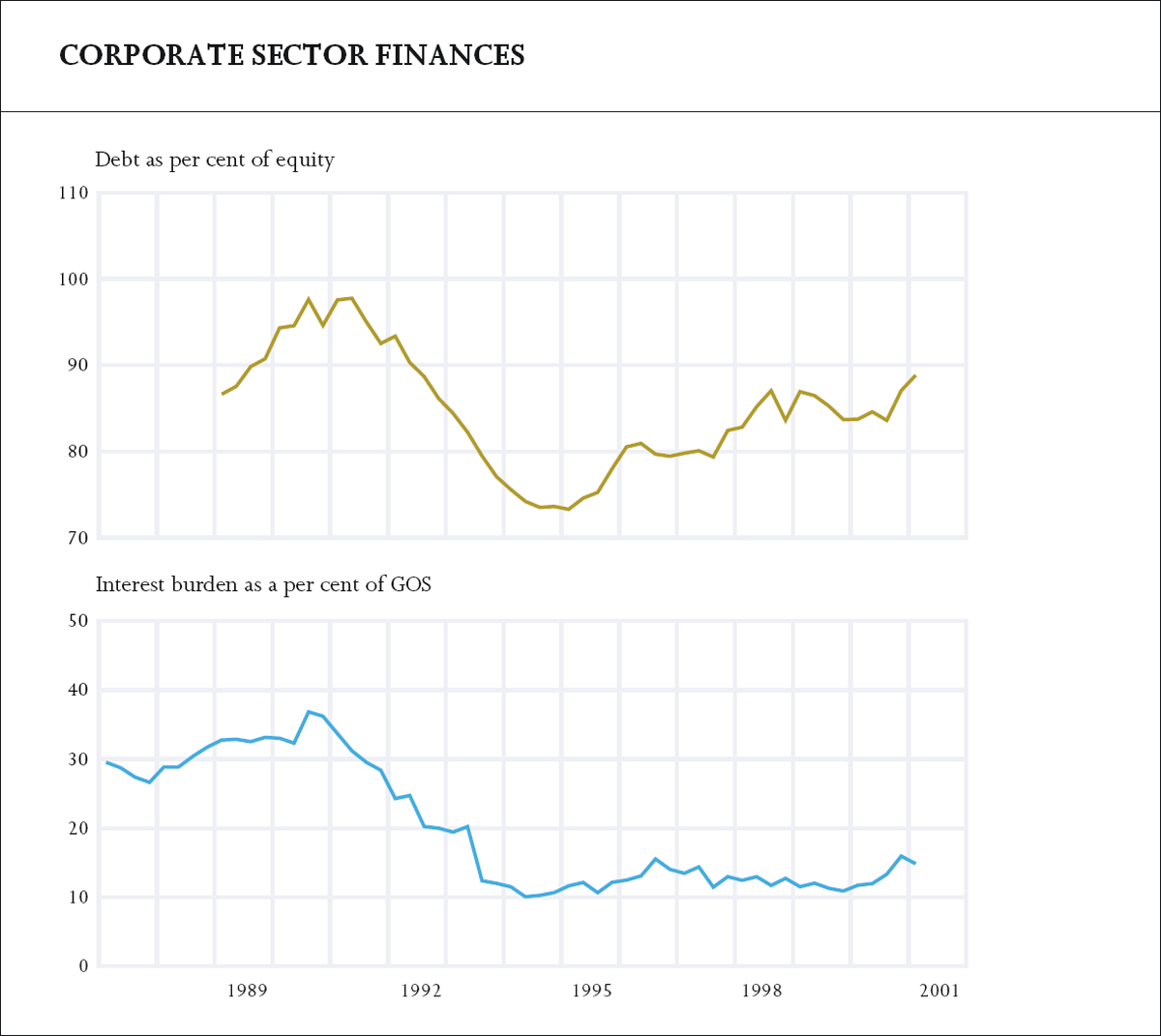
Second, there is little evidence of imbalances in individual sectors, particularly construction, which could pose risk for financial institutions. Speculative activity in the construction sector has been far more restrained than in previous expansions; non-dwelling construction as a share of GDP is low compared to late 1980s levels and commercial property prices in real terms remain nearly 40 per cent below their peak. In any event, the share of financial institutions' balance sheets exposed to commercial property has fallen over the decade; for banks, the share is currently around seven per cent. Commercial property developments have been increasingly funded from market sources through listed property trusts. Australian financial institutions have only limited exposures to the telecommunications sector, a matter of prudential concern in other countries.
Third, market indicators show continued confidence in the credit quality of the business sector generally, with credit spreads for low- and high-grade corporate bonds remaining relatively steady or declining during 2000/01. This contrasts with developments in the United States where concerns over credit quality saw spreads widen across all rating grades during the first half of the year, before narrowing more recently. Market confidence has also been reflected in the resilience of the Australian share market compared with share markets in the United States and elsewhere.
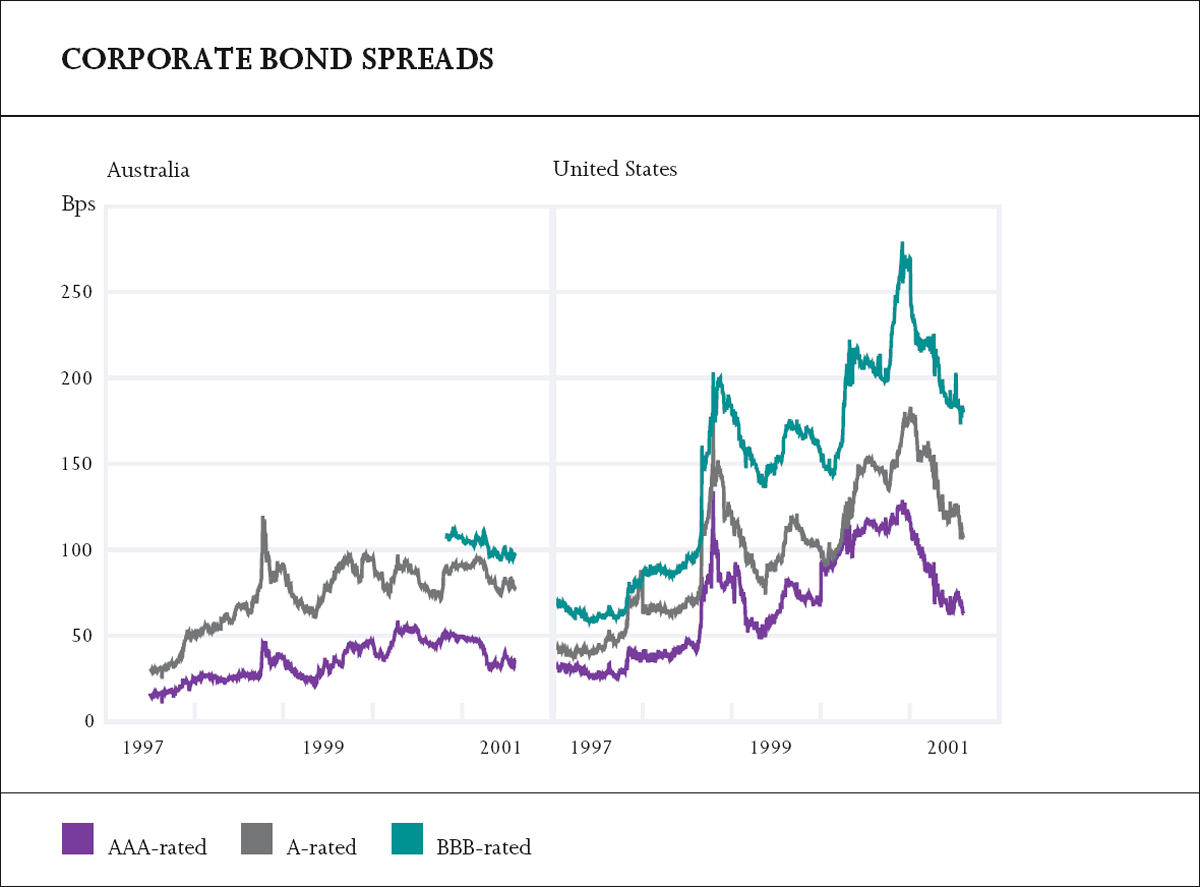
The absence of immediate stresses in the household and business sectors has meant that, notwithstanding the slowing of economic activity, authorised deposit-taking institutions remain in sound condition, and asset quality is strong. For banks, the ratio of impaired assets to total assets reached a low point of 0.5 per cent at mid-year. However, this measure tends to be backward-looking and can be expected to rise as the consequences of the economic slowdown materialise. More recent readings confirm that the credit quality of some business lending, particularly for small and medium enterprises, has deteriorated. Small businesses have felt the impact of recent falls in sales and business confidence more than other types of business.
Developments in impaired assets will bear close watching. At the same time, there are good reasons for believing that authorised deposit-taking institutions are less vulnerable to changes in the economic climate than they were a decade ago. Over this period, the concentration of risk in the financial system has changed. Financial institutions have shifted their lending portfolios away from businesses and towards the household sector, which is generally lower risk; the result has been a reduction in the overall risk on domestic lending portfolios. Lending to households now accounts for over half of total credit outstanding compared with one-third at the beginning of the 1990s. The management of credit risk has also been considerably strengthened through improvements in risk monitoring, such as the application of internal credit-grading systems, the shifting of credit risk through securitisation programs and use of credit derivatives, and tight control over the number and size of large exposures. The diversification of income sources into funds management and other fee-generating activities has also reduced the dependence of larger financial institutions on their traditional lending business.
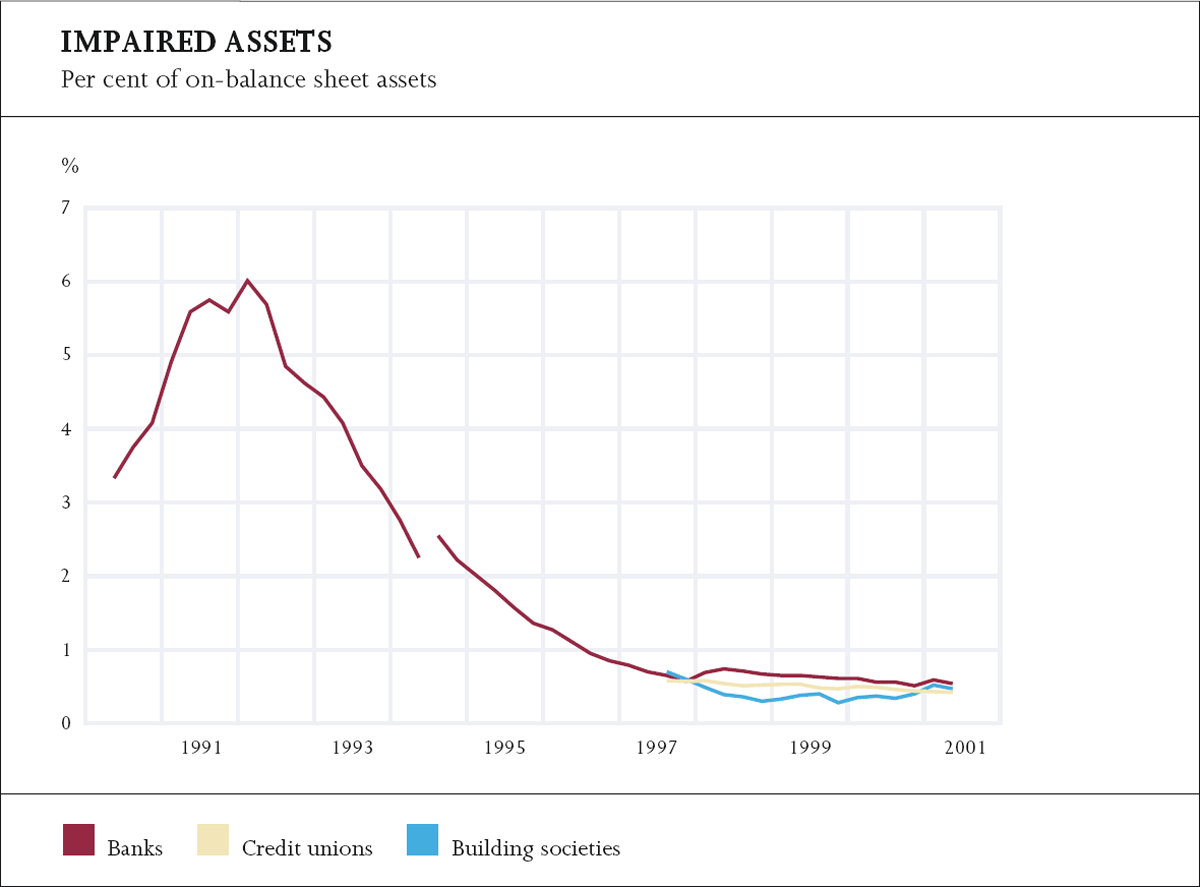
To fund sustained asset growth over recent years, financial institutions – particularly banks – have relied increasingly on borrowings in offshore wholesale markets as a supplement to their domestic deposit base. At the end of 2000, 60 per cent of Australia's gross foreign debt was accounted for by financial institutions. The Australian banking sector carries more foreign borrowings on its balance sheet than is the practice in other countries. However, this does not translate directly into foreign currency exposure. Almost half of the foreign debt issued by Australian financial institutions is denominated in Australian dollars; for the remaining foreign-currency denominated debt, the currency risk is largely hedged through off-balance sheet transactions in the derivatives markets, using currency swaps and forward foreign exchange contracts. Overall, the capital charge on banks' exposure to the risk of losses from market movements is less than one per cent of their capital base.
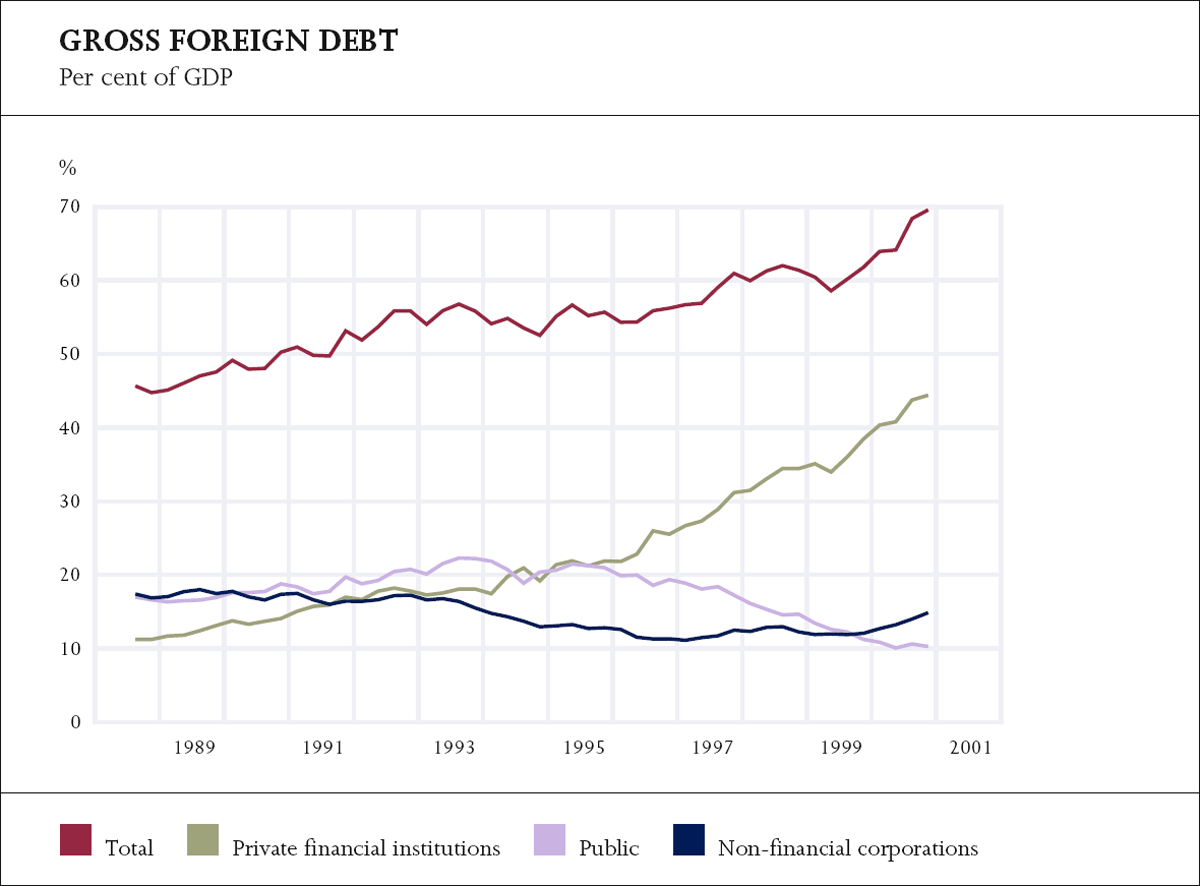
The profitability of deposit-taking institutions has been strong although, again, this measure is backward-looking. On average, banks have maintained returns on equity in the 14–16 per cent range (after tax) as a result of increased lending volumes, further cost containment and growth in non-interest income; however, banks' average interest margins continue to contract, partly as a result of the increasing use of wholesale funding sources. Returns on equity for building societies and credit unions – which tend to be higher cost institutions than banks and have higher capital ratios – have averaged around 6–7 per cent (after tax) over recent years. Sustained profitability has enabled deposit-taking institutions to maintain capital ratios well above minimum required levels. For banks, an active capital management program, involving share buy-backs and the use of innovative capital instruments, has seen the aggregate risk-weighted capital ratio remain around 10 per cent over 2000/01, just above its lowest level over the 1990s expansion. Provisioning as a share of on-balance sheet assets has been steady over recent years, although more forward-looking approaches might have seen provisions being built up in anticipation of a turn in economic conditions. For building societies and credit unions, capital ratios are close to or at cyclical highs.
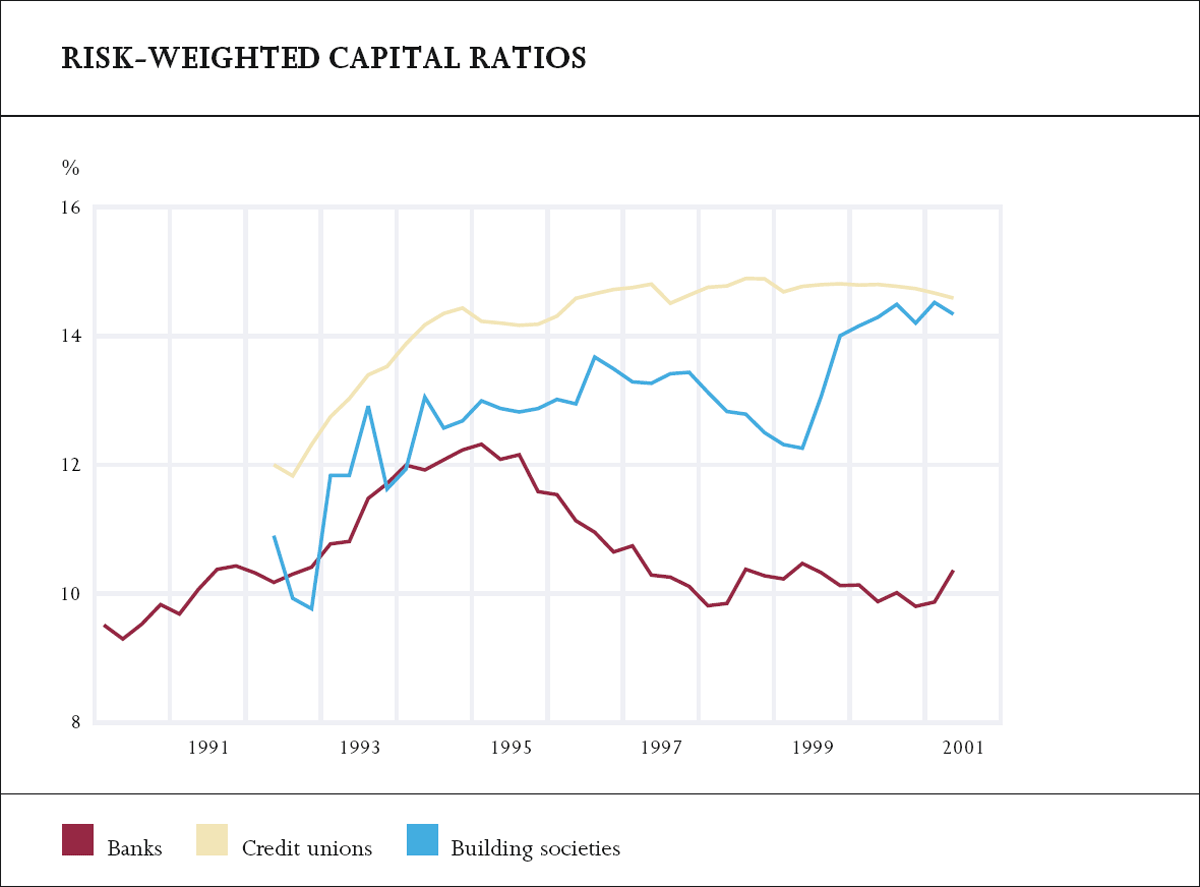
Market indicators continue to signal confidence in the risk profile of Australian banks. The credit spreads on AA-rated bonds issued by Australian banks has declined to around 50 basis points; this is their lowest level in two years and contrasts with the widening of credit spreads on equivalent US bank bonds, which peaked at 100 basis points in mid-year but have since declined. The credit ratings of the major Australian banks have been unchanged over the past three years.
Developments in the General Insurance Sector
The exception to the broadly positive picture of the Australian financial system is general insurance (including reinsurance), which has struggled for profitability and has had some significant failures over the past two years. During 1999/2000, one specialist reinsurance company, New Cap Re, went into liquidation and another, Reinsurance Australia Corporation (ReAc), into run-off mode. In addition, GIO Insurance Limited reported large losses from reinsurance business, for the second year in a row. In March 2001, HIH Insurance Limited, the second biggest general insurance company in Australia, was placed into provisional liquidation. Although the size of HIH's deficiency has yet to be determined, the collapse is likely to be as large as any failure of a financial institution in Australia's history. The reasons behind the demise of HIH, and the adequacy and appropriateness of the regulatory environment for general insurance, are now the subject of a Royal Commission.
The collapse of HIH has had some impact on output and activity, particularly in housing construction where builders previously insured with HIH have taken time to find replacement cover. The collapse did not, however, create the kind of stresses in the financial system that might have been expected with the failure of a deposit-taking institution of comparable size. Unlike deposits, the liabilities of general insurance companies are not repayable on demand. Hence, they do not lend themselves to the kind of ‘run’ that can befall deposit-taking institutions when the failure of one institution has a contagious impact on confidence in the sector as a whole. Australian financial institutions have little direct exposure to HIH and most of that is secured; while secondary exposures are likely to emerge as a result of their customers losing insurance cover, financial institutions are currently in a strong position to absorb any resulting credit losses. The winding-up of HIH has also not involved the distressed selling of financial assets on a scale large enough to destabilise financial markets.
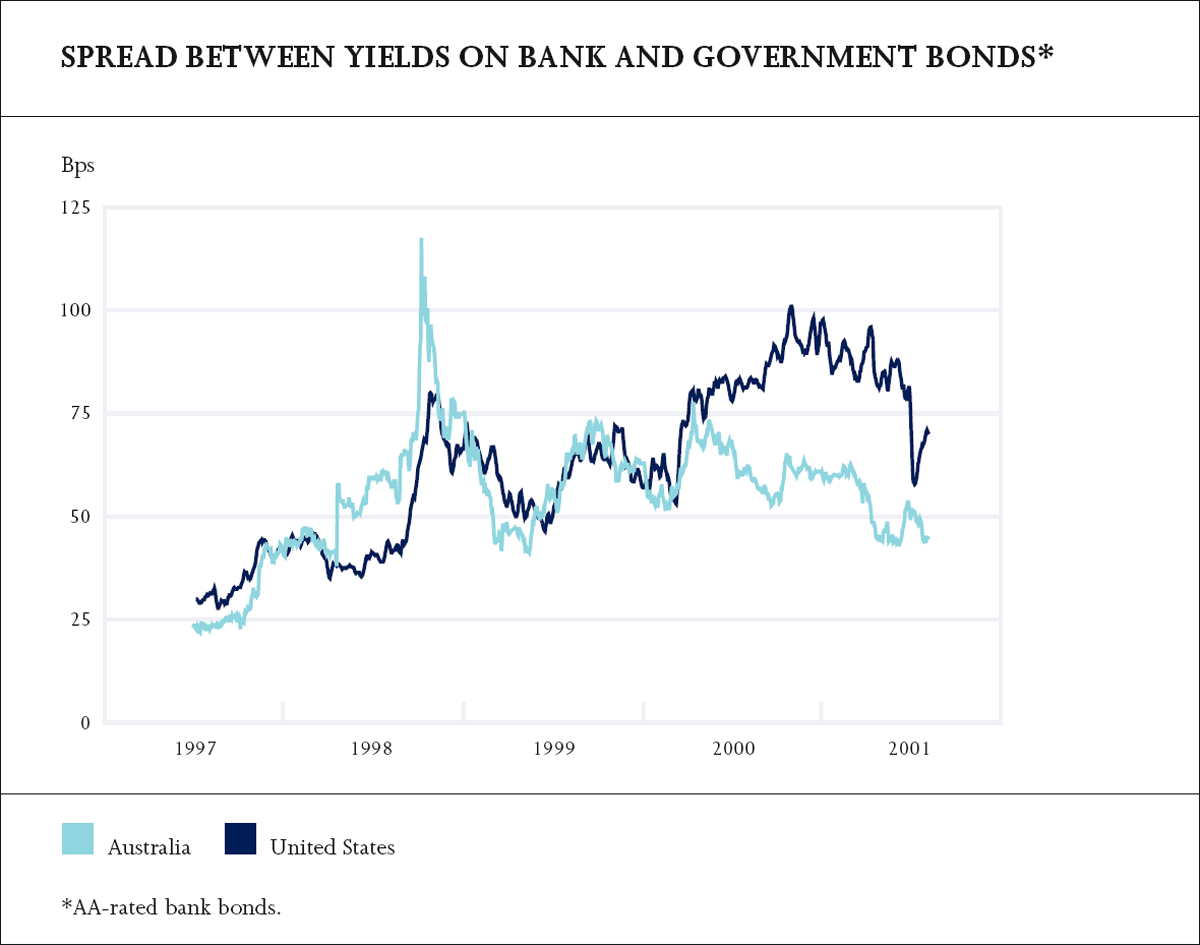
The failure of HIH, following the previous incidences of distress, has reinforced the importance of overhauling the regulatory framework for general insurance, which has seen little change over almost three decades. APRA has developed significant reforms to the prudential requirements for general insurers which will come into effect, under an accelerated timetable, from 1 July 2002.
Payments System Developments
The Payments System Board of the RBA has responsibility for the safety of the Australian payments system and for promoting efficiency and competition within that system, consistent with overall financial stability. It has the backing of comprehensive powers, to be exercised if other methods of implementation prove to be ineffective.
These powers were invoked for the first time in April 2001, when the RBA brought the credit card systems operated in Australia by Bankcard, MasterCard and Visa under its regulatory oversight. This followed a detailed study of card schemes, conducted jointly with the Australian Competition and Consumer Commission (ACCC) and published in October 2000, which highlighted a number of shortcomings in competition in the provision of card services. The RBA is currently assessing whether the rules of these schemes – covering the collective setting of wholesale fees (known as interchange fees), admission of institutions as members and restrictions on merchants passing on credit card costs to customers – meet a public interest test. A regulatory framework for credit cards will be established during 2001/02 after full public consultation.
On the safety front, the Payments System Board has continued to support the RBA's involvement in the ‘continuous linked settlement’ or CLS Bank which, once operational, will reduce foreign exchange settlement risk for participants (see the chapter on ‘Business Services’). Major Australian banks are participants in CLS Bank and the Australian dollar is included as an eligible currency.
The Government has recently introduced legislation, under its Corporate Law Economic Reform Program, that will widen the mandate of the Payments System Board by giving it responsibility for the setting of financial stability standards for securities clearing and settlement systems. This responsibility is a recognition of the close interaction between clearing and settlement systems and the payments system, and of the reality that the failure of a clearing and settlement system could have a serious impact on overall financial stability, a matter for which the RBA already has responsibility. Financial stability standards will address the financial soundness of a clearing and settlement facility, and could cover such matters as legal foundations, settlement procedures, risk control techniques, contingency planning and procedures to deal with default by a member. The RBA will undertake regular assessments of compliance with the standards set and if any enforcement action is needed, it would be undertaken on the RBA's behalf by the Australian Securities and Investments Commission (ASIC). Because ASIC also has a range of responsibilities for the operation of clearing and settlement systems, the RBA and ASIC are preparing a Memorandum of Understanding as a basis for co-ordinating their roles.
The Payments System Board's activities will be detailed in its third Annual Report to be published shortly.